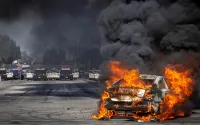22 December 2006Simon Calder
Another day at Heathrow, another debacle. The fog grew thicker; the queues longer, deeper, more desperate, and, in true Christmas-tale fashion, no more hotel beds were to be had within miles of the world's busiest airport. And today, it will get worse - nearly 200,000 are due to travel through the airport today.
Everyone had a sorry story: from the couple emigrating to Australia; to the student trying to make a connecting flight from Washington; to the family of five huddled together in a freezing tent with blankets, but without food or luggage. And because Heathrow is key to the nation's aviation system, the chaos was spreading to other airports.
Yesterday, Heathrow saw its aircraft handling capacity reduced by 40 per cent compared with normal operations.
About 300 flights were cancelled, bringing to 700 the total since the fog descended on Tuesday - the vast majority short-haul operations. British Airways again axed all its domestic flights to and from Heathrow, plus 100 European services. Lufthansa, BMI and Alitalia also experienced significant levels of cancellations.
All because of fog? Partly. But the weather simply conceals the root of this week's airport chaos: the aviation infrastructure in the south-east of England is abjectly short of capacity. The most precious real estate in Britain is not in the City, but just south of the M4 in west London: the pair of runways at Heathrow, where a pair of "slots" can change hands for millions of pounds.
There is no prospect of imminent expansion. Heathrow's £4.3bn Terminal 5 is due to open in March 2008. Although it will provide more potential sleeping space for involuntarily overnighting passengers, it does not address the central issue: that the pair of runways at Heathrow can barely cope at the best of times, and these are the worst of times. Other airports of a similar stature operate with three, four, or five runways.
Plans for a shorter third runway north of the airport, and extra airstrips at Gatwick and Stansted, are stalled at the planning and financing stage. Arguments about new runways tangle awkwardly with the broader debate on the true environmental costs of aviation and who should pay them. These questions have been kicked into the long grass.
On a day of thousands of losers, though, there were the odd winners. Yesterday afternoon, a few lucky travellers aboard British Airways flight 2940 found themselves unexpectedly upgraded to Club World. So far, so good. But they had only a brief in-flight interlude in which to experience the flat beds and video-on-demand for the flight lasted barely an hour - it was a shuttle between Gatwick and Edinburgh. Four days before Christmas, BA was obliged to replace a few-frills Boeing 737 with a more comfortable 777 usually reserved for transatlantic routes.
The key word at BA's headquarters west of London yesterday was not "service" but "dispersal", as senior managers sought to shift the steadily growing population of stressed passengers at Heathrow and Gatwick. The absurdity of using a long-haul jet to boost capacity on a hop to Scotland exposed the scale of BA's desperation - as did its latest diversification.
Yesterday, the world's favourite airline became a bus operator. Three thousand passengers were dispatched by coach from Heathrow to destinations in northern England and Scotland, while travellers desperate enough to leave the country by any means were offered seats in buses to Amsterdam and Paris.
In addition, British Airways had booked 3,000 rooms at hotels near Heathrow. Most of the occupants were transit passengers, whose journeys turned into a nightmare for one reason: they had bought tickets that required a change of planes at Heathrow.
One-third of BA's business involves selling flights via London. Yesterday, inbound travellers on delayed flights from continental Europe discovered that their long-haul connections had already left, and that they would have to stand by for spare seats on flights leaving today or tomorrow to their final destination. They found themselves jostling for a shrinking amount of available space with travellers who had made their way to the capital from the north of Britain by road or rail and are seeking seats to replace those on the flights they have missed.
Terminal 4, where BA has its main intercontinental base, is the scene of some of the worst problems. When the Prince and Princess of Wales opened the terminal in 1986, it was never envisaged that the top floor of the short-term car park would support a compound of marquees that resemble an inferior version of Guantanamo Bay, with worse weather and food. The blanket of fog currently sitting over southern England was blamed by both British Airways and the airport owner, the British Airports Authority, for the latest meltdown in Middlesex. While modern aircraft equipped with "Category 3" auto-land equipment are perfectly able to operate in thick fog, the low-visibility procedures imposed by air traffic controllers operating with just two runways drastically slow the rate of arrivals and departures as aircraft are more widely spaced.
And what will the legacy be? Each of today's 40,000 new victims of the hiatus will tell their own sad story. They may vow to become more risk averse by avoiding Heathrow and British Airways for important journeys. And if that happens, another bunch of winners will emerge from the wreckage of broken dreams: the airports and airlines of Amsterdam, Frankfurt and Paris.
http://news.independent.co.uk/uk/transport/article2094673.ece






